Detroit residents and civic groups protesting water shutoffs
(text by Philip Verma)
Sustainability is a buzzword in contemporary urban policy circles but the desire to remake cities can implicate authoritarian planning practices in which community needs are subjugated to desires of property developers. This confrontation of so-called sustainable development and community rights is currently playing out in Detroit, a city that is sometimes considered a “blank slate” for innovative urban sustainability projects. Since March of this year, more than 15,000 Detroit residents have had their water turned off by the city. The Detroit Water and Sewer Department (DWSD) claims these shutoffs are a necessary way to enforce collections on delinquent accounts. This is a charade, part of a larger pattern of privatization and gentrification in Detroit, as many community activists have pointed out. Furthermore, we should question what kind of sustainability demands mass displacement and the suspension of democratic rights as prerequisites. The shutoffs are not about financial or environmental sustainability; instead they are a way to get rid of long-time residents—predominantly poor and Black—so that the whiter, wealthier new wave can enjoy a greener, cleaner, smoother city.
It is important to consider the historical process in Detroit as urban divestment as opposed to decay, implying deliberate practice rather than natural happenstance. Across the United States after World War II, white middle-class families began leaving city centers for suburbs, facilitated by cheap, racially-exclusive home loans provided by the federal government and the creation of the Interstate Highway System in 1956. Detroit, the center of the U.S. automobile industry, developed into a sprawling city of around 1.8 million people, with many more living in the wealthier suburbs. Postindustrial Detroit reflects this shortsighted planning paradigm; its population has dropped to around 700,000, it has next to no public transit (a system of 35 local buses over 143 sq mi), and its primary rail station closed in 1988. The overstretching of city services has led planners to propose shrinking the city into several smaller population centers and turning about a third of the city’s land into parks, community gardens, and greenways. It is undoubtedly an innovative idea for a sprawling city but “shrinking” Detroit is not a frictionless process; it would entail massive community displacement with unforeseeable consequences for current residents.
Despite being the perennial icon of industrial decline, Detroit has recently become hip among venture capitalists and urban farmers alike, an opportunity for cheap investment in “the next big thing.” At a tech conference in June 2014 in Detroit, the Brookings Institution declared part of the city an “innovation district” to be transformed through mass transit, research institutions, start-up tech firms, and small cafes and bookstores. Construction has also begun on a light rail line connecting the rapidly-developing downtown and New Center neighborhoods. The recent interest in Detroit accompanies nationwide gentrification patterns, as evidenced by skyrocketing rents in New York, San Francisco and Washington, DC. Urban cores are at last receiving needed investments in infrastructure and beautification (such as parks, bike lanes, improved transit, sanitation) precisely at the moment that long-time residents are being forced out. This begs the question: if Detroit is to be rebuilt to be more economically viable and environmentally sustainable, whom will this revitalization serve?
Gentrification in Detroit is more sinister, however. It is the latest city to fall prey to what Naomi Klein termed disaster capitalism, in which governments abdicate responsibility in economic or environmental disaster areas to contractors, speculators and private human services providers. After the federal government’s terrible response to Hurricane Katrina in August 2005, for example, private contractors stepped in to provide disaster relief services, closely followed by a host of conservative lobbyists and consultants to retool and privatize New Orleans’ public housing, transport, health, and education systems. Due to historically low property values in contemporary Detroit, speculation and land grabs are rampant; venture capitalist Dan Gilbert recently bought 9 million square feet of land in the city center for as little as $8 per square foot. Furthermore, some essential services, like lighting and security, are now provided by business owners and private contractors instead of the government. All of this brings us to the issue at hand: water.
Detroit sits on the Great Lakes, which hold 20% of the world’s fresh water
The UN considers water a human right, a necessary resource for the realization of other fundamental rights, and has therefore criticized the shutoffs in Detroit. Here in Colombia in 2012, Bogota’s mayor Gustavo Petro established a vital minimum for drinking water for the poorest sectors of the population, allowing around 3 million of the city’s residents to access a minimum amount of drinking water regardless of ability to pay. It is important to note that Detroit, one of the poorest cities in the U.S., has seen water and sewage rates more than double in the last decade. What is more, community activists have pointed out that the real roots of DWSD’s financial trouble are in fact its predatory municipal bonds from UBS (a company whose executives were convicted of bond fraud) and that the overdue accounts are really a scapegoat. Capping water rates based on income and establishing a vital minimum would increase access for poorer Detroit residents and create a plan that is more sustainable in the long-term.
This issue of rights to resources ties into a larger theme of democratic participation in city and transport planning. In 2006, the Michigan Welfare Rights Organization (MRWO) proposed a comprehensive, community-created water affordability plan for Detroit that would have helped 40% of low-income residents pay their water bills consistently by tying rates to income and would have funded DWSD in perpetuity.The plan, based on successful plans in other cities, was approved by the city council but rejected by the Department, which implemented a stop-gap measure that helped very few people and did not close the budgetary gap. More alarmingly, in March 2013, the conservative governor of Michigan appointed an emergency city manager, Kevyn Orr, to deal with the crisis in Detroit. Orr quickly filed for bankruptcy, allowing the city to renege on its pension obligations and start to sell off its assets: its utilities, its waterfront properties, even its world-renowned art collection. Notably, Orr was never elected, meaning that for Detroit’s 700,000 residents—of whom 83% are Black and 42% below the poverty line—their rights to the city had been suspended.
Low-income communities of color bear the brunt of urban planning changes in the United States, from suburban sprawl and white flight in the 1950s to compact greenness and gentrification today. Environmentally-friendly development without protections for existing neighborhoods or communities (for rents, utilities and property values, for small businesses, for community centers and public spaces) is not sustainable; it is displacement colored green. What is the purpose of urban sustainable development if not to provide access to healthy food, adequate healthcare, quality education, safe transportation, and stable housing to the city’s most marginalized? Detroit communities have rights to water and to their city. Most of all, they have the right to democratically plan an urban future in which their needs come first.
Watch the short documentary- Detroit Water Shutoffs – for more information on the issues









Comentarios recientes